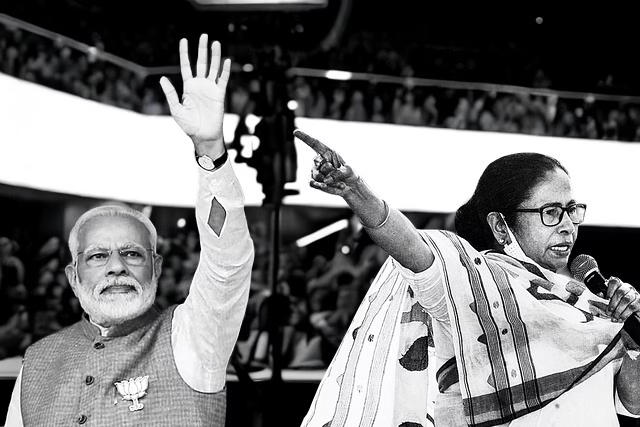In Indian politics, two things are easy to claim and hard to prove: inevitability and immunity. The Bharatiya Janata Party (BJP) learned this in Delhi, after failing to win the assembly for over a decade, it finally stormed to power in 2025. Now, emboldened, the party is targeting the two most stubborn holdouts in its national expansion: West Bengal and Punjab.
Both have defied the BJP’s rise. Both have deep-rooted political cultures hostile to Hindutva’s central narrative. And yet, both are showing signs of internal erosion and the BJP is watching closely.
Bengal: Mamata’s Wall Is Cracking
West Bengal is no longer unbreachable. In 2021, the BJP won 77 seats and 38% of the vote, unthinkable numbers just a few years prior. The party has built a massive organizational base, especially in rural Bengal. Union Minister Dharmendra Pradhan says the BJP needs just a 10% swing to flip the state. That’s not fantasy. That’s math.
And there’s fuel. The Sandeshkhali sexual assault scandal, the R.G. Kar doctor’s murder, and repeated corruption allegations involving TMC leaders, including Abhishek Banerjee, have damaged Mamata Banerjee’s image. Suvendu Adhikari, once her confidant, now leads the BJP’s warpath with vengeance in every speech. “2026 Bengal ki baari hai,” he says, and BJP cadres believe it.
The BJP’s slogan “Hindu Hindu Bhai Bhai, 2026 BJP Chahi” reveals the strategy: consolidate the Hindu vote (70% of Bengal’s population), fracture Muslim voting blocs, and leverage welfare fatigue. TMC’s split from the INDIA bloc weakens opposition arithmetic. Alone, Mamata fights on two fronts: BJP’s rise and Congress’s revenge.
But she’s not done. Her Lakshmir Bhandar welfare program, rural Panchayat grip, and personal appeal, especially among women and Muslims, still give her a serious edge. The BJP may be loud, but Mamata has depth.
The key challenge for the BJP? No Bengal face. Suvendu isn’t Mamata. Without a charismatic Bengali to lead the charge, Modi and Shah must do the heavy lifting again. Also, Bengal’s cultural resistance to religious polarization runs deep. The BJP must win more than just outrage. It must win trust.
Punjab: Still a Long Shot. But Not Impossible.
Punjab is even tougher. The BJP was politically exiled during the farm law protests. It’s widely seen as anti-Sikh and anti-farmer. Yet the Aam Aadmi Party (AAP), in power since 2022, has underdelivered. Job promises, anti-drug campaigns, and local governance have all fallen flat. The Ludhiana West bypoll in 2025, though technically a win for AAP, exposed cracks: a narrow margin, reduced turnout, and clear fatigue.
The Congress? Still alive, but leaderless. It’s bleeding relevance amid factional fights and national irrelevance. Voters don’t see an alternative yet, but they’re looking.
The BJP is betting on that vacuum. Its urban strategy, focused on Ludhiana, Amritsar, Jalandhar, mimics its Delhi template: attack AAP’s governance, highlight Modi’s infrastructure push, and court Hindu and OBC voters. It is even reopening conversations with SAD dissidents. No alliances are confirmed but backchannel talks exist.
Still, Punjab won’t fall easily. The BJP’s brand remains radioactive in rural Sikh circles. And AAP’s welfare populism still appeals to the poor. If CM Bhagwant Mann survives criticism and Kejriwal reins in his national ambitions, AAP can hold. If not, the BJP will circle—and Congress may watch helplessly.
The Delhi Effect
The BJP’s 2025 Delhi sweep (48 of 70 seats) was more than symbolic. It showed that strong local anti-incumbency, a fragmented opposition, and targeted campaigning can crack even deeply entrenched opponents. Delhi’s Bengali voters tilted toward the BJP. The same model, welfare failure, corruption fatigue, and Hindu consolidation, is being tested in Bengal and Punjab now.
If Delhi was a dress rehearsal, Bengal is the stage. Punjab is the test.
The Real Challenge: Narrative vs. Identity
To win Bengal, the BJP must go beyond aggression. It needs a narrative of belonging. “Outsider” rhetoric still stings in Bengal. Modi rallies can’t replace local roots. Without a credible Bengali face and cultural fluency, Hindu consolidation alone won’t deliver a majority.
In Punjab, the Sikh-Hindu divide remains BJP’s largest barrier. Unless the party reframes itself as pro-development, pro-business, and culturally sensitive to Punjab’s unique identity, it may remain an urban fringe player.
Final Word
Can the BJP conquer Bengal and Punjab in 2026? Not guaranteed. But not impossible.
Mamata Banerjee’s hold is shaking. AAP’s glow is fading. Congress is flatlining. The BJP doesn’t need to win every seat, it needs to bleed its rivals, split the vote, and emerge as the only party with national gravity.
If it can replicate Delhi’s formula: fewer but doable promises, more anti-incumbency momentum, relentless boots-on-ground work, it may rewrite electoral history once again.


Leave a Reply